How Biology Has Changed
When biological research was mostly done through academia, regulation of NIH funding was enough to keep things secure. But as biohacking becomes more prevalent, regulatory law hasn’t kept pace. As biological tinkering becomes feasible for mere interested hobbyists or small corporations, we’ll need policy work to prevent catastrophe and protect the promise of a biology innovation renaissance. This lightning talk, given by Tessa Alexanian, was recorded at Effective Altruism Global 2018: San Francisco. A transcript of Tessa's talk is below, which we have lightly edited for clarity.
Hey everyone, so you heard I'm styling myself as a professional robot whisperer, an amateur biohacker and an occasional meetup organizer, and that's more or less accurate. I'm going to talk about laboratory automation and some biosecurity implications, sort of. I submitted the title for this talk prior to writing it, but I, I will be talking about lab automation, but mostly because I think that's a really important part of the story of how biology has changed. So we're doing biology in a whole lot of new places, and I think our norms and regulations around biosecurity have not really kept pace with that. When I think about how biology has changed, I usually like to think back about 40 years. That's when we had the first recombinant DNA and this is what things looked like then.
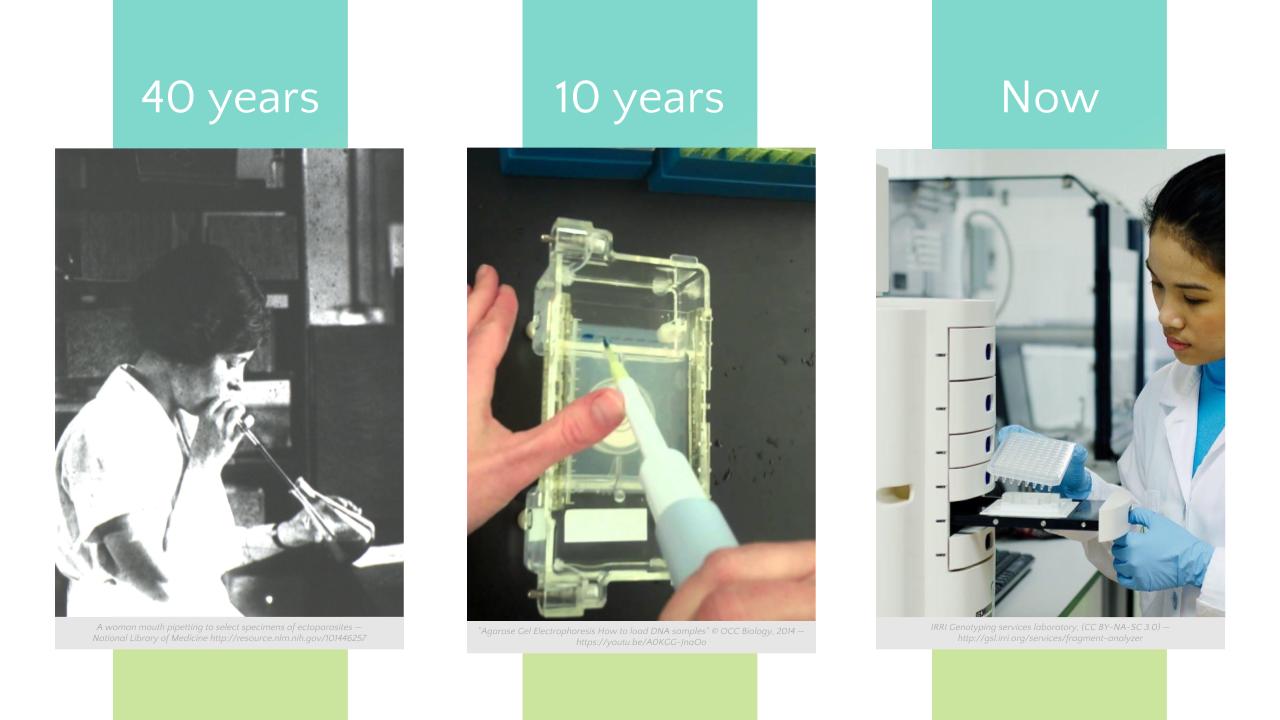
She's pipetting with her mouth back in 1975. They put out the Asilomar Principles and they had to specifically forbid people from pipetting bacteria with their mouths, which I find horrifying.
And uh, you know, I'm in a privileged position because I work as a lab automation engineer. And so I also get to be kind of horrified by this middle picture, normal gel electrophoresis, because I'm used to working with robots like the ones on the right, which can do this kind of common lab work about an order of magnitude faster. And I can't talk about how biology has changed without showing you this graph.
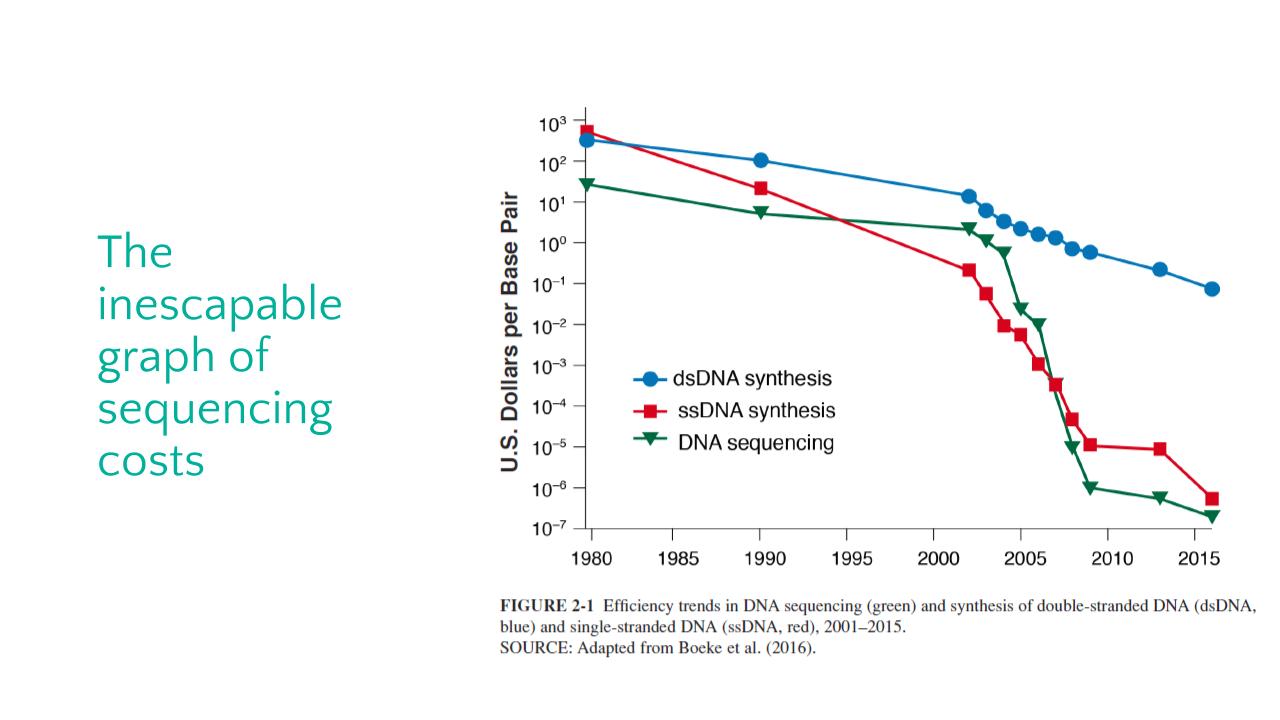
So about a decade ago, well I guess two decades ago now, the turn of the century: human genome project, it took us a decade of work and it cost $3 billion. If you want to sequence a human genome today, it costs you about a thousand dollars and it will take you about a day. And we are well on our way to $100 genome and you see the same kind of trends in DNA synthesis costs. At this point, you know, this has all been enabled by new hardware.
At this point, if you are an individual, you can more or less have all of the tools you need to read, write and edit DNA in your home. So if you want to read DNA, there's this USB powered DNA sequencer, which I think that's cool that that exists. It's called the minION and it costs about a thousand dollars.
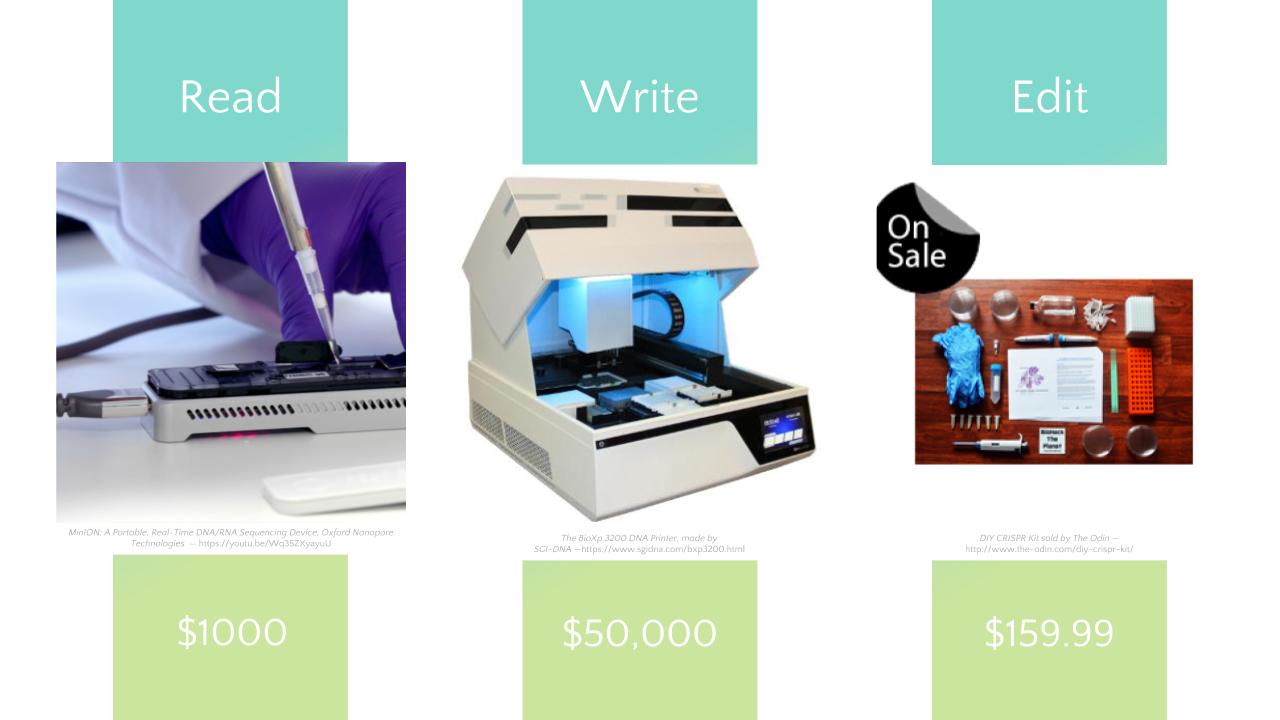
Most of us in this room probably could not afford this thing in the middle. It's a DNA printer, but a lab for example, it could totally have this on their bench top. It costs about 50k. And then we're in the bay area. If you want to edit genomes, there is a local startup for that. This is the DIY CRISPR kit from The Odin and it will only set you back $159.99. And I really want to emphasize that a decade ago this didn't exist. There were no cheap tools for this even five years ago.
And so what all that means is that biology has become much cheaper and faster to engineer. And that means that we are doing biology in new places. It used to be that if you wanted to do molecular biology, you were in an academic context. You are in a research lab. Now you can sequence genomes on your kitchen counter and, sometimes that is really wholesome.

This is actually a picture from an educational nonprofit in New York. They're called Bionoma Collabs. They bring students up to their lab, AKA their kitchen, and they have them sequence genomes of novel plants that have never been sequenced before, and they submit those to public databases. So they're doing education. The students get lab skills. And they're also expanding human knowledge and I love it. I think this is great. And there's also a lot of new for profit biology.
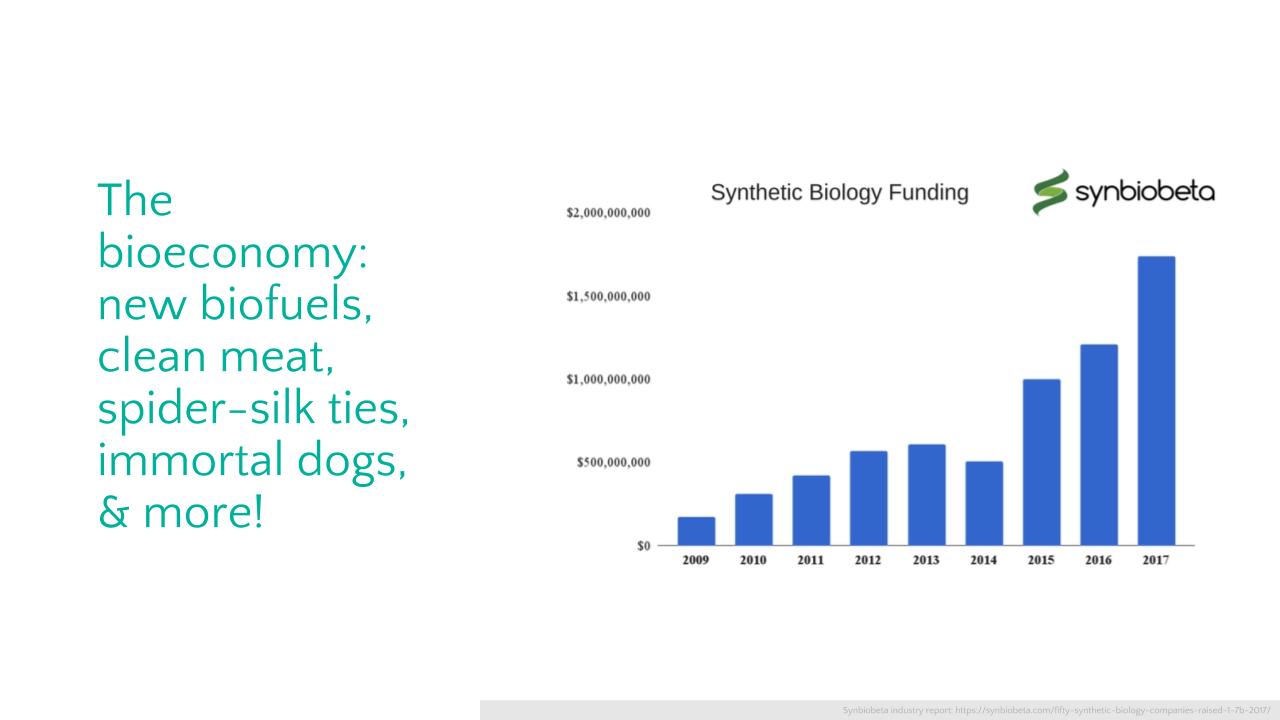
So this is a graph from a local org, you know, increasing venture capital investment in synthetic biology and it's not just venture capitalists that are interested. More than 40 countries have released a strategy for the national bio-economy. And a lot of these companies are so cool. They're doing really amazing science fiction things. I do want clean meat. I want new biofuels, I want spider silk ties, immortal dogs. I would like all of that, please. And yet, you know, I'm worried that as we're doing this and as biology is moving to new places, we are not keeping it safe. I probably don't need to tell anyone in this room that technology moves faster than policy. And so I want to spend the rest of this talk talking about some ways that the policy has not necessarily kept pace. I'm going to start by talking about lab safety.
So Asilomar Conference, the place where they said please do not mouth pipette your bacteria: they put up this system of biosafety levels and if you've ever worked in a biology lab in Europe or North America, you have probably known that you were working at BSL one, or BSL two or BSL three if you're really fancy. So these specified containment and safety procedures, and the NIH in the US thought, this is great. We're gonna adopt this. We're going to make following these safety procedures a part of getting funding from us. This was a piece of regulation that worked great when we had academic biology. All of the biology that was being done was dependent on NIH funding, and so it was this effective enforcement of these biosafety regulations. Now when you have commercial labs and community labs, it doesn't work so well. Well, sort of. Most of the community labs I've been to, they still follow these biosafety levels because they were all trained in academia.
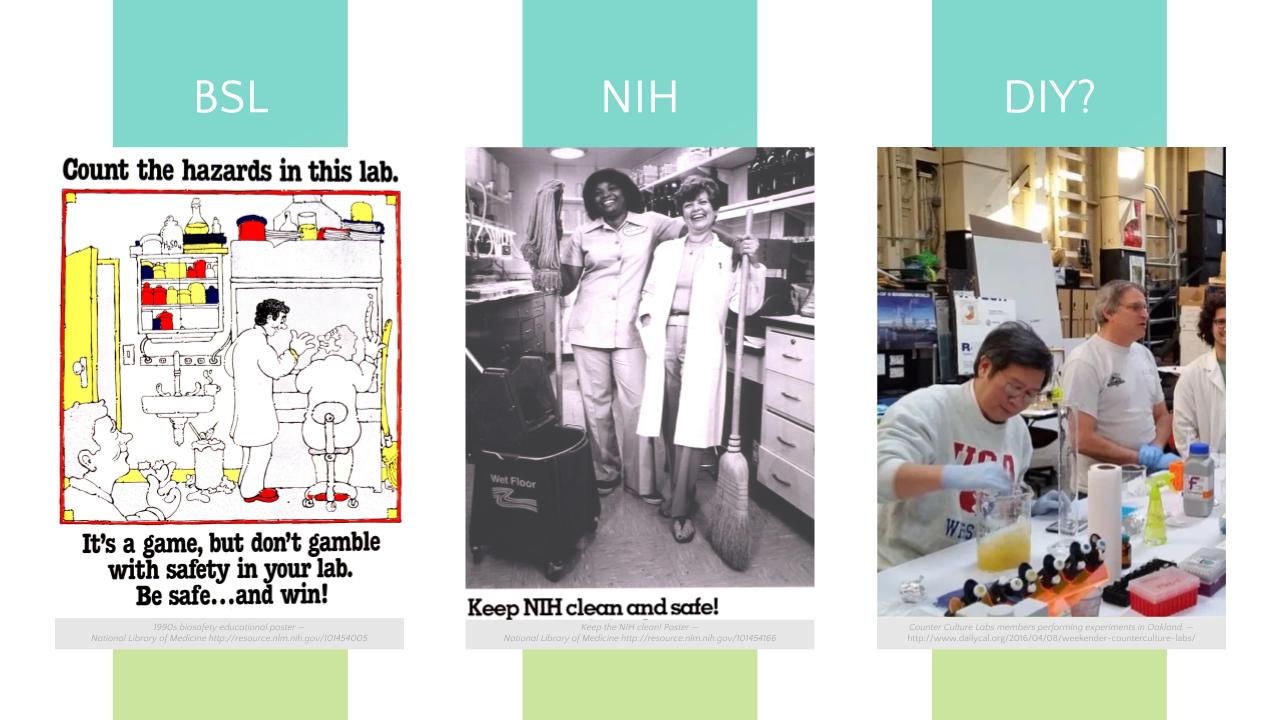
There's kind of these strong norms about biosafety levels, but I want to emphasize that we're dependent here on norms and heuristics. Another place where there isn't really official regulation is in-gene synthesis. So nowadays you can order a semi-arbitrary sequence of genes and get those, get those synthesized for yourself. And back in 2009, there was a publication in Nature Biotechnology, going, maybe this is not great, maybe someone's going to order smallpox or something. We should probably put locks on the DNA printers and prevent them from printing dangerous sequences. The gene synthesis companies were not stoked about this. And so they requested... they put out this huge announcement. They said we're going to start screening everything against a database of known pathogens and this kind of screening protocol grew in popularity. They formed this international gene synthesis consortium, 80 percent of gene synthesis capacity uses their screening protocol and that's all cool.
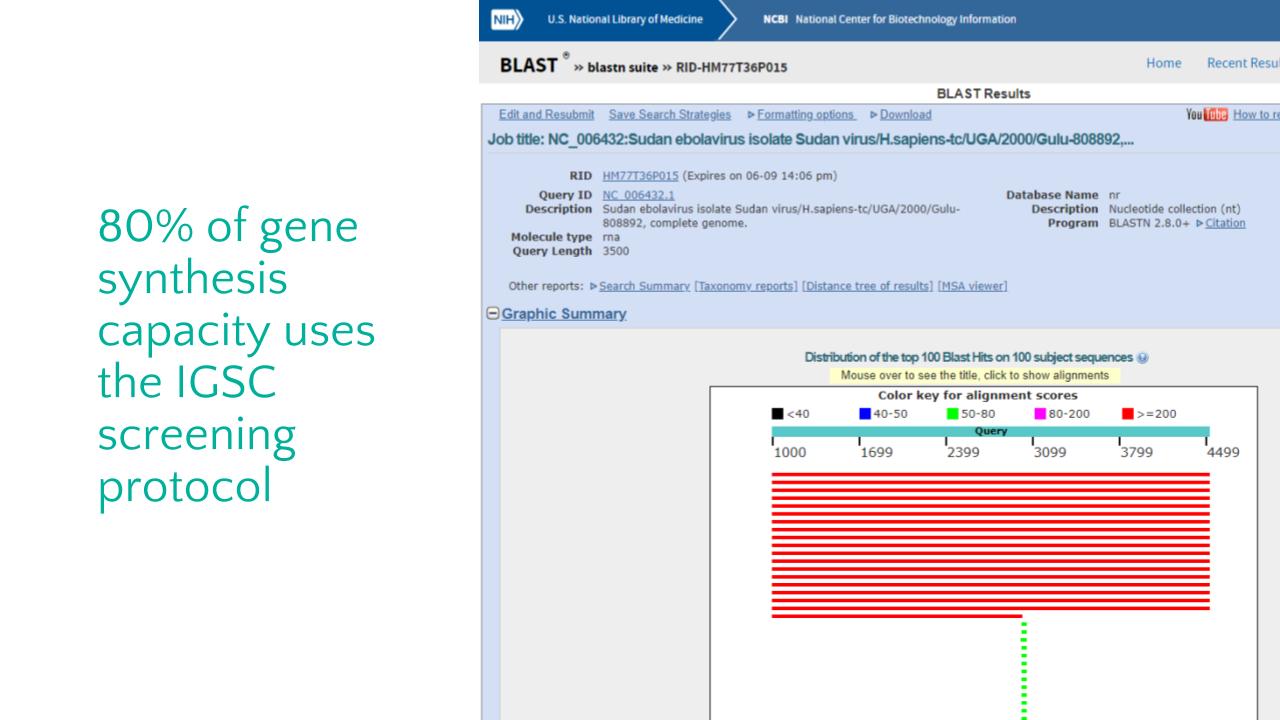
But you know, those synthesis companies have said we are open to being regulated nationally. We think this kind of screening should be required by national regulation and right now it is not. So this is not reassuring, but you might be thinking well at least these things are going to get regulated if they're ever getting, you know, getting released into the public coming to market, and that is sort of true. The US has this coordinated regulatory framework for the regulation of biotechnology, made it in 1986, and I sort of feel like if you have to put coordinated in the name, maybe it's hard to coordinate and depending on what kind of biology product you are making, you might be regulated by the NIH or the FDA or the EPA or the USDA or some unholy combination of all of those organizations. And even with all of those organizations, things can still fall through the cracks.
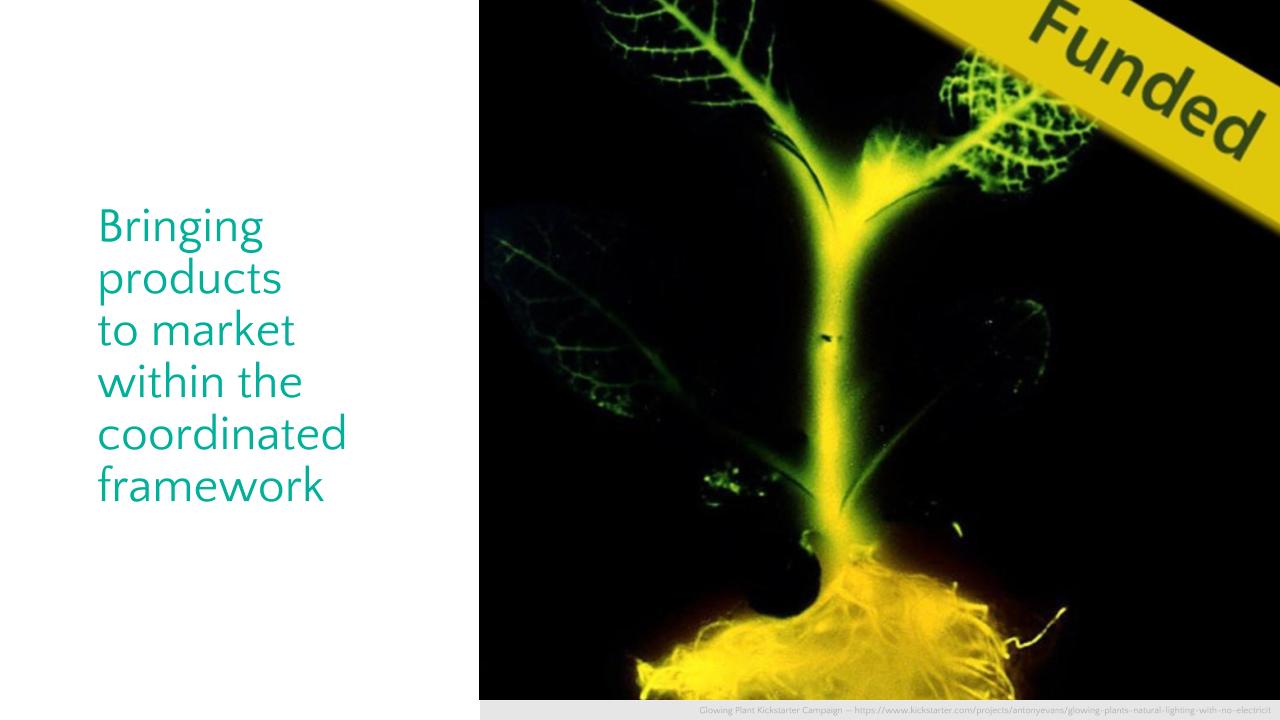
So I think the glowing plant is an interesting example. They crowdfunded in 2013 on Kickstarter, so NIH funding is out, and they're also, I'm going to try to quote a National Academy of Sciences report here but I might get it wrong. They're not a plant or animal, they are not a novel plant pest or pesticide. They're not producing a novel chemical and they are not an inter-generic microorganism in commerce, which means in short that they were nobody's responsibility. So how do we stay responsible? How do we bring biosecurity to all of these new places where biology is happening? Well, this is the part where I say I'm doing a lightning talk, so I'm skipping over a lot and especially I'm skipping over a lot of the international context, but I do want to briefly touch on the bio weapons convention. The BWC. It's a big piece of international regulation. It forms an important part of that story. And what they've decided to do this year, they're having a meeting of experts about developments in science and technology and their plan is to develop a code of conduct for biologists.
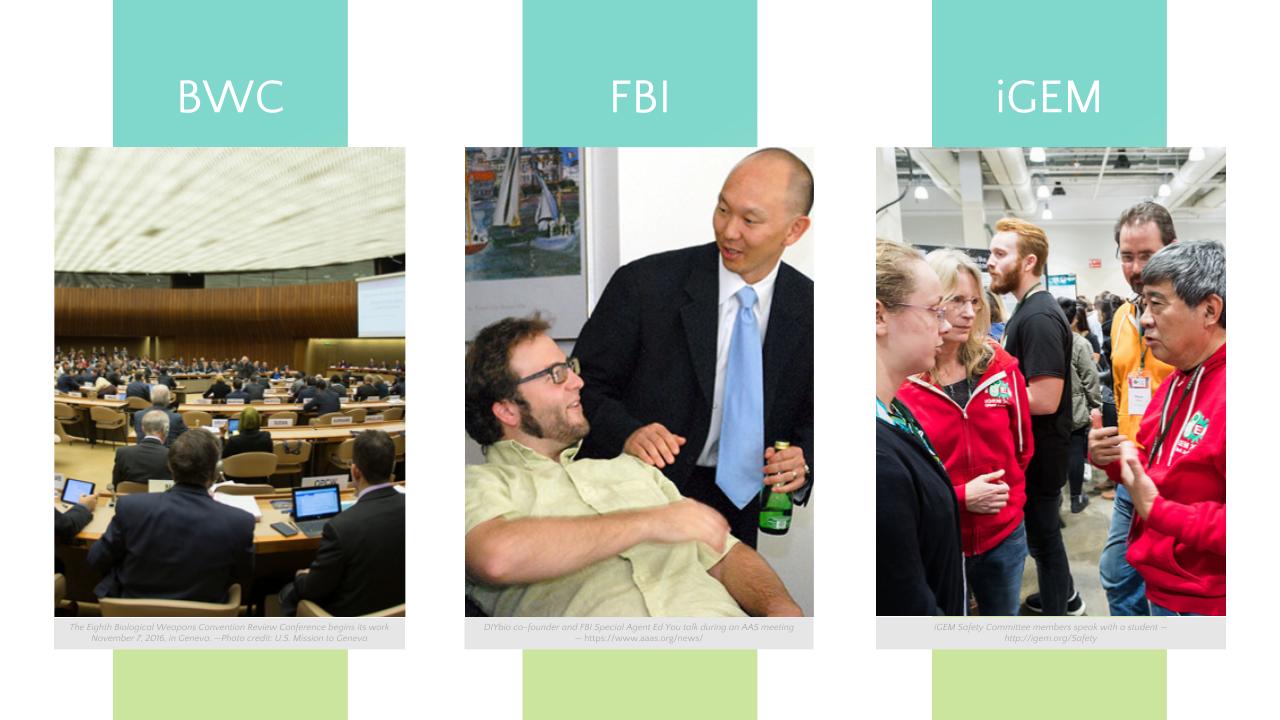
So again, that's kind of regulating through norms. Here in the US, the FBI has a bioterrorism countermeasures unit and in my experience, what they do is they go to community biolabs and introduce themselves, and I've had an FBI agent who's sort of come up to me and say, hey, you know, I'm your neighborhood FBI agent, if you see anything that makes you uncomfortable, here's my card, just give me a call. So it's kind of via relationships. And then, another kind of norm setting thing is this iGEM competition. They're an international competition that is basically trying to funnel all of the students in the world who are interested in synthetic biology through them, so that they can emphasize safety and security and hopefully set norms in this emerging field. So we have norms, maybe... maybe not the best way to do regulation.
I think norms are really important, but I don't think they're adequate on their own, especially because, you know, I've just scratched the surface. There's a lot more technology coming. One example I want to give, last year the Venter Lab published this digital to biological converter. And so this is something that takes the bio, the DNA synthesis, the printer that I showed you earlier, and it connects it to a bunch of other hardware and so it can print not only DNA but also RNA and various polymer is even viruses. And in a world in which you can email someone some instructions and they can use a machine like this to print out a virus, a lot of our containment regulations about: put locks on the door of your lab and make sure your freezers are, you know, well tracked so no one can sneak in and take a vial out of them, they're no longer really meaningful.
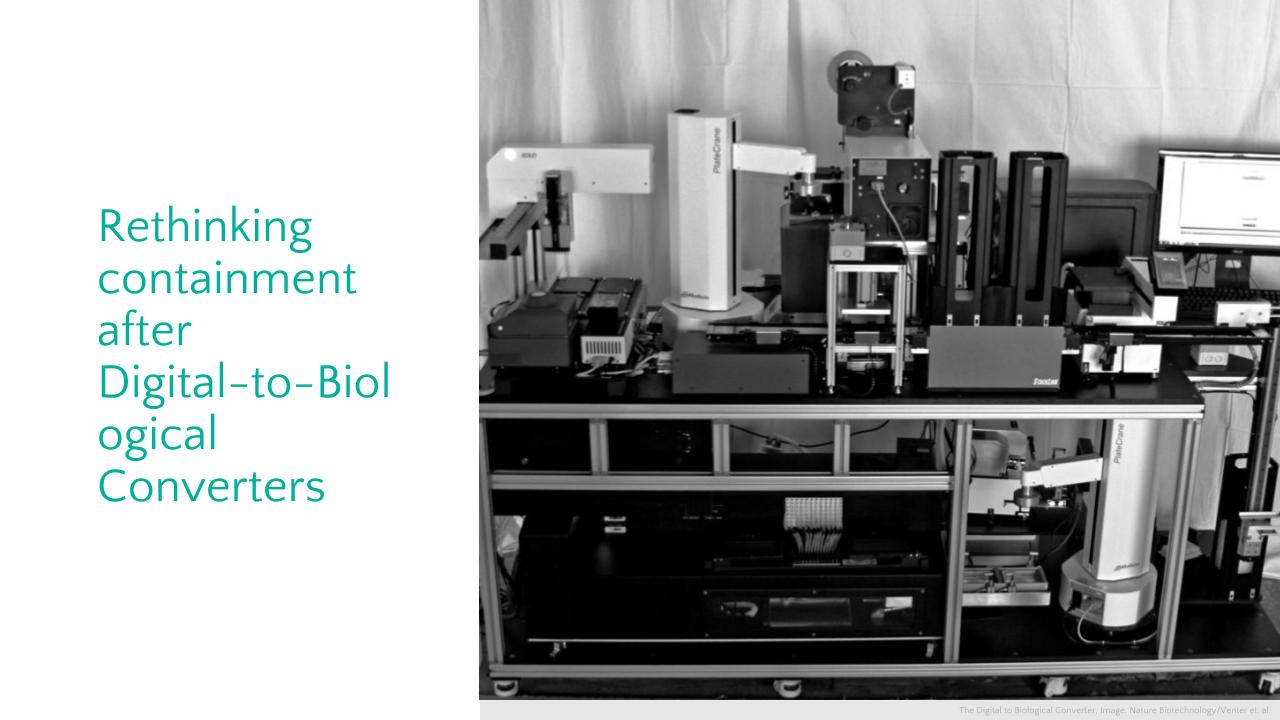
And, that brings me to why I wanted to give this talk, which is that I think it is very difficult for people and especially regulators to keep pace with all of the biotechnology that is happening, and all the new places where we are doing biology. And I think it's really important to be aware, and at least maybe now you folks are more aware of some of these emerging technologies. In the reports I read over and over again, they say we need to do more horizon scanning or we need to develop better risk assessment protocols. And to me that sounds like the kind of research that effective altruists might be interested in, maybe even some of you.
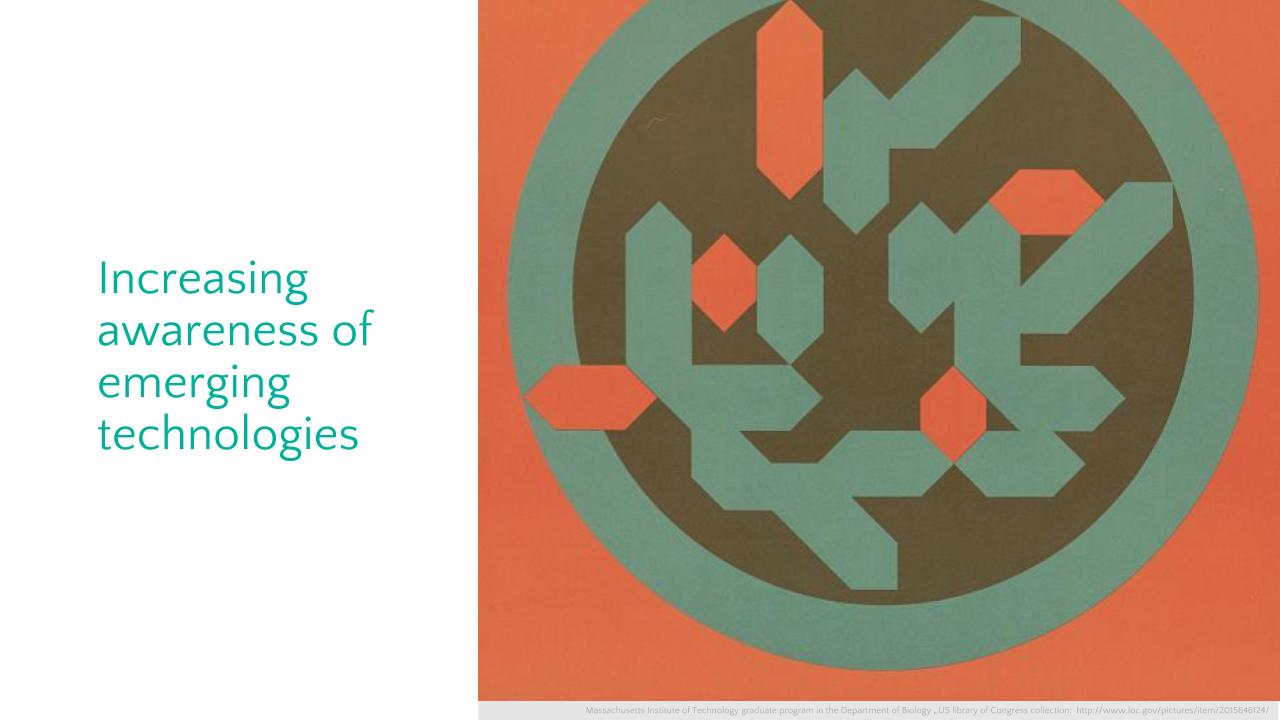
And I just want to end by talking about something that kind of worries me, which is that over and over again, the story I hear from people is that they are waiting for something to go wrong for some do it yourself biologist to really hurt themselves, or for some DNA synthesis company to miss a dangerous order or some, some other thing that I won't even speculate about. And uh, let's not, let's not wait for something to go wrong. I really think that that life is better with biology and that we can have a really cool 21st century of biology, but only if we keep it safe. Thanks.